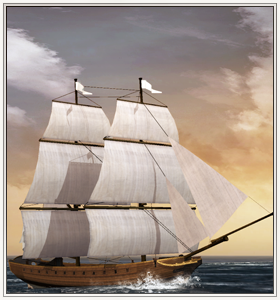Brig (ETW unit)
| Brig | |||||
|---|---|---|---|---|---|

| |||||
| Faction: | |
|
|
| |
| Range: | 500 | 500 | 500 | 500 | 500 |
| Accuracy: | 70 | 80 | 70 | 70 | 70 |
| Reloading skill: | 60 | 60 | 75 | 60 | 70 |
| Hull strength: | 1194 | 1220 | 1258 | 1194 | 1258 |
| Speed: | 22 | 23 | 22 | 22 | 22 |
| Maneuverability: | High | High | High | High | High |
| Morale: | 8 | 8 | 9 | 8 | 9 |
| Turns to build: | 1 | 1 | 1 | 1 | 1 |
| Recruitment cost: | 700 | 750 | 700 | 680 | 670 |
| Upkeep cost: | 170 | 180 | 170 | 170 | 160 |
| Requires | |||||
| Building (minimum level) | |||||
| Local Fishery | |||||
| Shipyard | |||||
| Trading Port | |||||
A brig is a lightly armed, small, two-masted sailing ship, much prized for its exceptional handling and sailing qualities.
The term “brig” is a contraction of “brigantine” (an earlier sailing ship design), although the two types do not have the same rigging. A brigantine carries fore-and-aft sails, while a brig is square-rigged; this explains why the brig was favoured, for square rigging requires far fewer skilled hands to sail the vessel. The term “brig” could also include many rigging sets, including the strangely named “hermaphrodite brig”, which had a square-rigged forward mast and schooner-rigged aft (main) mast.
All brigs, in the hands of a good captain, are handy little ships, and can virtually turn in their own length. This manoeuvrability partly makes up for the light armament, usually no more than a couple of cannon – and those no larger than 12-lbers. The development of carronades (short-barrelled, short-range, large-bore weapons) added to a brig’s firepower.
Historically, the fledgling United States Navy used brigs, particularly on the Great Lakes. USN brigs also put up a brave account of themselves against the Barbary Pirates.
Technological abilities
Available for:
| |
|
|
|
|
|
| |
|
|
|
|
|


